Puerto Maldonado’s festivities are a vibrant blend of tradition and culture, celebrating the region’s rich heritage. Colorful parades, lively music, and traditional dances fill the streets with joy. Locals and visitors enjoy delicious Amazonian cuisine and artisan markets. These celebrations honor history, nature, and the spirit of the community.
Which festivity are you looking for?
JANUARY
23th
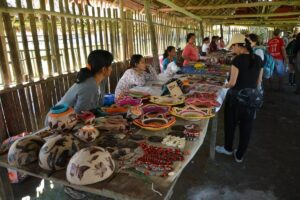
Peruvian Handicraft Day
“The crafts of the area are made with plants, fibers, seeds and sylvan roots. You can find elaborate pieces from ancestral times such as bows and pona arrows adorned with feathers, typical clothes made with bark of yanchama trees and adorned with seeds and feathers, necklaces, earrings and bracelets made with seeds and animal teeth. At the moment wood carvings are also made, canvases with images of people, animals and landscapes, ashtrays, paperweights and keychains in chestnut coconut, as well as wooden postcards and various ornaments. On this day, the Minister of Foreign Trade and Tourism, Eduardo Ferreyros, offered a cordial greeting and indicated that thanks to their skill and dexterity, they present to the world, not only beautiful creations, but also the history and traditions of Peru. He commented that our craftsmanship is a reason for recognition and prestige. Through it the world visits Peru as well as our history and the diversity that defines us as a nation. Craft lines: There are artisanal lines, such as textiles, jewelery, ceramics, imagery, carving, vegetable fibers, masks, toys, imagery, aquaculture products, costume jewelery, among others. Peruvian handicrafts enjoy national and international recognition and prestige and invited the national population to visit artisan centers to celebrate artisans and to acquire their products. Crafts are valued for their quality and their own style as a result of the integration of various cultures, generating an identity of high aesthetic content and deep richness.”
FEBRUARY
1th

Jungle Carnival Celebration
“The carnival is an annual event full of color, rhythm and joy. All parts of Peru present a particular way of celebrating it, in the case of Puerto Maldonado, Carnival becomes a good reason to revalue the customs of the Peruvian Amazon. The carnivals present a movable date from the first days of February until the end of March and every year they present a new theme, for example since the carnival of 2011 this took the name of Mombiré Ayanda which are words in the native language that means Dance Together and that is precisely what carnival is about and since then every year has a new theme to revalue. Among the activities of the carnival are the tours or parades of comparsas and floats in what is intended to manifest jungle motifs regarding the design and decoration of their vehicles. In the course that is also programmed the music and native dances are of greater importance the revaluation of the traditional jungle that is made in Puerto Maldonado capital of the Madre de Dios region. In these dates the election of the lady of the jungle carnival is also scheduled. There are other contests that are held for carnivals, among them: The carnival contest of typical dances, in addition to the Contest of stick taught or of Lights, Contest of Widows (the plañideras that interpret to the debtors of the deceased king Momo, spirit of the carnival) . On the final day of the Carnival is presents the celebration of what is known as the Tomb of the Ushna or Yunsada which is something like what is known as yunza in other parts of Peru. In the same way this day the farewell of King Momo is performed as a symbol of the end of Carnival. Auditions or television or press conferences, although they seem unusual at this time, are also present, especially in the days leading up to the Carnival, this in order to disseminate and make known to visitors, or future visitors, the programming of Carnival activities to come, in addition to the theme of celebration. Carnival usually begins its activities in the Plaza de Armas of Puerto Maldonado and has the participation of the authorities of the region and the comparsas of the city, in this way the traditional party begins. In the last years the carnivals also take the name of ‘Mombire Ayanda’, arakbut word that means ‘Let’s dance together’ and that seeks to strengthen the identity of the jungle region of Madre de Dios. The entity that is responsible for carrying out the Carnival is the Regional Government of Madre de Dios whose objective is to rescue traditional customs of Puerto Maldonado and transmit them to new generations. The Plaza de armas of Puerto Maldonado and the leisure centers, such as the traditional Manguare and the Buraco are the meeting points of the population where the good atmosphere is combined with music from the jungle and the Brazilian samba. Every year in the carnival the comparsas stand out, with picturesque names such as: The gypsies, the corsairs enter others, who celebrate their 40th birthday by participating in the carnival. Normally in a weekend more than 5 thousand people go to the main points where the carnival is celebrated, being the oldest the Manguare.”
APRIL
1th
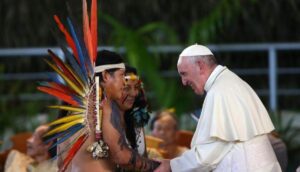
Holy Week
“Holy Week is one of the most attended religious festivities and expected by Peruvians, either for the various cultural events that revolve around it or because the 2019 holidays can be used to rest or travel to the interior of the country in the case of Puerto Maldonado. It consists in celebrating the joy of the resurrection of Christ, is the slogan of the churches and parishes of Puerto Maldonado and nearby towns, that on Sunday of glory its members and faithful, participate in various sports games and gymkhana, after activities such as eating fish not drink liquor, not eat pork or aji, the whole village shows the devotion of the Maternitans or residents of Madre de Dios, who go to churches and processions in this week. On this Sunday from early in the morning, many children, young people and adults of different ages gathered at the Santa Cruz de Madre de Dios Parish Educational Institution Sports Center to kick off the day. The words of welcome are normally given by the Bishop of the city, who, prior to the integration games, accompanies the opening ceremony with those present. Each year the public institutions of Madre de Dios publish their calendars and events for Easter with street maps showing the main processions. The celebrations begin on the Friday before Palm Sunday and continue for 7 days until Easter Sunday. Held one week before Easter, this is the most attended religious festival in Peru and attracts visitors from all over the country. The biggest procession takes place on Friday morning, some traditional dances of the Peruvian Amazon, events and street art exhibitions, sporting events, agricultural fairs and the loving preparation of traditional foods. The celebrations culminate on the Saturday before Easter Sunday with a great all-night party that includes the dawn fireworks to celebrate the resurrection of Christ. If you also want to party, take the case forecasts late at night. Crime in the city increases during the festivities. In the morning, parish priests from different parts of the region gather to be part of this week’s celebration at the Cathedral of Puerto Maldonado, which is Holy Week with the aim of reaffirming our faith. The celebration for Holy Week in Puerto Maldonado, Madre de Dios region, is carried out with. Some faithful from distant villages get ready early to arrive at the Cathedral of this city to celebrate the Mass of Holy Thursday and at this time in Puerto Maldonado you can see that from very early the doors of the markets open like the Mercado Modelo , Father Aldamis and May 3 to sell essential products.”
MAY
3th
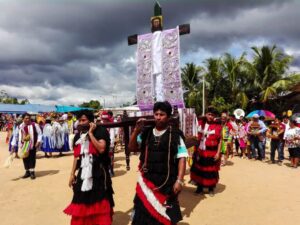
Feast Of The Cross
“Cruz velacuy in Madre de Dios has the purpose of paying homage to the crosses that exist in our region. This tradition was introduced by the high Andean settlers who came to this part of the jungle and brought their customs and celebrations with them. One of the first Catholic elements used very effectively was the Cross, in the case of the Tawantinsuyo, the crosses were located in the various places and sacred sites, which were abode or shrine of the Andean gods, being a symbol of good against the evil, is present everywhere and at all times, permanently deserving the spiritual invocation. This celebration took place in the first decades of the 18th century. When at that time it was a relatively humble family holiday without the importance it has today. The cross is a symbol of Christianity in the same way for Catholics is the representation of the passion of Jesus Christ. After the Spanish conquest, the cross was one of the elements of struggle and ideological quarrel to evangelize the Americans and also to facilitate their submission, so their worship and use were obligatory in the new world, the “”extirpators of idolatries”” By destroying their Inca sanctuaries they were very careful to place crosses in their place. The celebration of the cross usually has a steward or “”carguyoq”” the person who voluntarily agreed to organize and make most of the expenses for the celebration, who is almost always a person with high resources and owner of a house where an altar will rise for the cross. The beginning of the festival is on May 2 with the descent of the cross from the top of the hill or sanctuary where it is. On the 3rd of May it is carried out in the whole area of Cusco and in recent years also in Puerto Maldonado universal sense and with much hullabaloo, is to worship the cross. May month when the fields begin harvesting the corn or harvest the festival of the holy cross is very interesting, because all the crosses are illuminated and this is called the feast of the “”cruz velacuy”” or “”vigil of the cross”” This festival is carried out with enough solemnity since the crosses according to Catholic ideology, are the protectors against all negativity. In the evening the evening that is attended by the whole neighborhood, the past butlers, relatives, etc. takes place. Which consists in turn of making vigil of the cross, all night, a bonfire is lit in front of the altar that in the Province (Paruro of Cusco) they call it the “”cconucuy”” which is to bring the trunk of good thickness they say “” machu ccuyu “”which is its Castilianized form. In the festivity of the cross, the chicha parureña is inevitable or “”quellu aja”” is an essential drink made naturally. The joy continues to the rhythm of an orchestra (harp, violin, quenas and accordion) that play popular songs for all the attendees who dance very animated, also drunk with aguardiente and pisco. At midnight you can taste the lamb broth and the parish cancacho with all those present, that same night it is also announced to the butler for next year. On May 3, which is the central day, an Andean Catholic ritual is celebrated, which is the celebration of mass in the church of the Province of Paruro, for which the cross is moved in procession accompanied by an indigenous band of the place. Then the cross returns to the butler’s house also called “”cargo wasi”” where it is placed once more on his altar. At midday the mayordomos offer a festive lunch and during the afternoon the party continues with lots of drink and music, the next day is the “”kacharpari”” (the farewell party) takes place during the morning until noon where move the cross to its place of origin where it will be until next year.”
JUNE
25th
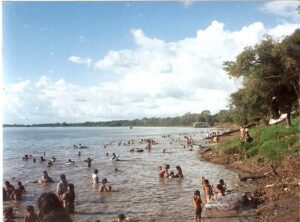
San Pedro And San Pablo Day
“Every year on June 29 is celebrated in Peru the day of San Pedro and San Pablo, date that for Puerto Maldonado is very special, especially for the inhabitants of the community of La Cachuela, where a great celebration will take place on the shores of the Mother of God river. In the program of activities, which has already been prepared, the fishing contest and other activities will be included. The celebration of San Pedro and San Juan was also celebrated by the communities of Baja Cachuela, Alta Cachuela, Centro Cachuela, who came together to share the fun. These festivities are celebrated every year and the aforementioned native town of Cachuela is located 6 kilometers from the regional capital, showing their best finery with natural settings arranged for the party. The program of activities includes a motocross race, fishing contests and other recreational activities and sports. The community of El Prado preserves the cultural identity of Madre de Dios, with its native groups of quenas and bombos and their traditional meals and drinks of yesteryear, which include pachamanca. The fiestas of San Pedro and San Pablo is a custom that takes place every year, in most of the towns that are located on our coasts. Beginning with the parties that are developed with activities and contests in the river. The festivities of June 29 continue to accompany the images of San Pedro and San Pablo, as a sign of gratitude and festivity of the fishermen. These celebrations with Hispanic elements, now have an identity of our lands, is a celebration that has about 90 years in our country, faithful devotees themselves or strangers attend all popular tributes. It lasts for eight days and the managers are called, Judges of Water, which are two, the Tapka, Judge of the top and Recuaino, judge of the lower part. The festivities begin on June 24, and they celebrate it with bands of musicians, castles, and motocross races, a day where water judges parade down the big street, accompanied by their Campos, Cabecillas, guests and folk artists, spreading the word tonadas that will be executed during the holidays. On the 27th with adoration and offerings, the Bajada de Pedro takes place, preparing the environment for the following days, June 28 and 29, where the population continues to pay tribute to the patron saint, in the midst of the rhythm of bands and musicians. The central day from 2 in the morning the dancers leave to do their show and after the mass they carry out the procession with the image of San Pedro crossing the main streets in the center of the city, in the middle of songs, praises and prayers, always accompanied by faithful devotees who at the end are concentrated in the main square, intensifying the joy until late at night the parties in the thriving city. Especially the festive days in homage to San Pedro and San Pablo, are held on July 29 and 30, while days before, on June 24 expresses his joys with his patronal feast, dedicated to his patron saint San Juan Bautista , this is where in all the houses of the field fires are lit at night, with wild flowers and with them they go down loaded to the mass of the town, between beautiful melodies of violins, tinyas and harps.”
JUNE
24th
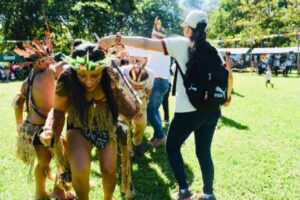
San Juan Festival
“The Fiesta de San Juan is an important religious celebration that takes place in the different cities of Peru, and that presents special devotion in the Peruvian Amazon. The festival of San Juan has its central day on June 24 and for this different events are held both religious and regional. The parties begin on the 23rd and by then different tourist routes are planned that are provided to the visitors with a purpose of encouraging tourism in the area. Among these routes is for example a free tour of the Charachamayoc Complex. In the celebration of the festival of San Juan there are also sports activities in which the different teams of the inhabitants participate. The religious ceremonies are not absent in the Feast of San Juan and the first of those celebrated in homage to the Saint is offered at night. In conjunction with this folkloric festival where the dances are exhibited, as well as exhibitions of different typical dishes of the region. Regarding the latter, it is necessary to mention that the juane has an important role as it is the main dish that is prepared and sold as a tribute to the festival of San Juan, in addition to organizing preparation skills. The main attractions are the tourist route of the Carachamayoc circuit, costumbristas dances and gastronomic fair. The main cities of the Peruvian jungle are preparing to celebrate the Fiesta de San Juan as Puerto Maldonado, Loreto, Tingo Maria, Ucayali and San Martin will receive you in a big way, with peculiar dances, exceptional exhibitions, craft fairs, extraordinary gastronomy and more . A celebration to which we should all go at least once in a lifetime. The main day is June 24, the date on which Saint John the Baptist is worshiped, a saint who is credited with purifying water. But a day earlier, on the eve, there are a series of activities that you must experience. Therefore, it is recommended that you travel a few days before the celebrations begin. On June 23, which is the eve, a population of men and women go to the river to ask for comfort to San Juan Bautista. This is known as the ‘blessed bath’ and it is what will give them happiness and health during the year. Although, before the party was held only regional music, over time have incorporated foreign and local customs. For that reason, you will have the happiness of merging with the local population and enjoying some magical days. Processions, parades, typical bands and walks. The jungle has an infinity of typical dishes and try them in the Fiesta de San Juan 2018 is part of the custom. As is the case of ‘Juane’, which represents the head of San Juan Bautista who, according to the bible, was decaptiated. The Juane is a dish prepared with rice, cilantro or chopstick, egg, olives and chicken, all wrapped in bijao leaves or banana tied with rope of banana or chapana. You will also taste the ‘Tacacho con Cecina’, the ‘Inchicape de gallina con peña’, ‘patarashca’, ‘Cazuela de pescado’, and more.”
JULY
20th
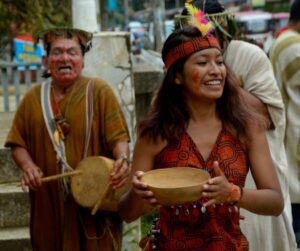
Peru Tourism Week
“Cruz velacuy in Madre de Dios has the purpose of paying homage to the crosses that exist in our region. This tradition was introduced by the high Andean settlers who came to this part of the jungle and brought their customs and celebrations with them. One of the first Catholic elements used very effectively was the Cross, in the case of the Tawantinsuyo, the crosses were located in the various places and sacred sites, which were abode or shrine of the Andean gods, being a symbol of good against the evil, is present everywhere and at all times, permanently deserving the spiritual invocation. This celebration took place in the first decades of the 18th century. When at that time it was a relatively humble family holiday without the importance it has today. The cross is a symbol of Christianity in the same way for Catholics is the representation of the passion of Jesus Christ. After the Spanish conquest, the cross was one of the elements of struggle and ideological quarrel to evangelize the Americans and also to facilitate their submission, so their worship and use were obligatory in the new world, the “”extirpators of idolatries”” By destroying their Inca sanctuaries they were very careful to place crosses in their place. The celebration of the cross usually has a steward or “”carguyoq”” the person who voluntarily agreed to organize and make most of the expenses for the celebration, who is almost always a person with high resources and owner of a house where an altar will rise for the cross. The beginning of the festival is on May 2 with the descent of the cross from the top of the hill or sanctuary where it is. On the 3rd of May it is carried out in the whole area of Cusco and in recent years also in Puerto Maldonado universal sense and with much hullabaloo, is to worship the cross. May month when the fields begin harvesting the corn or harvest the festival of the holy cross is very interesting, because all the crosses are illuminated and this is called the feast of the “”cruz velacuy”” or “”vigil of the cross”” This festival is carried out with enough solemnity since the crosses according to Catholic ideology, are the protectors against all negativity. In the evening the evening that is attended by the whole neighborhood, the past butlers, relatives, etc. takes place. Which consists in turn of making vigil of the cross, all night, a bonfire is lit in front of the altar that in the Province (Paruro of Cusco) they call it the “”cconucuy”” which is to bring the trunk of good thickness they say “” machu ccuyu “”which is its Castilianized form. In the festivity of the cross, the chicha parureña is inevitable or “”quellu aja”” is an essential drink made naturally. The joy continues to the rhythm of an orchestra (harp, violin, quenas and accordion) that play popular songs for all the attendees who dance very animated, also drunk with aguardiente and pisco. At midnight you can taste the lamb broth and the parish cancacho with all those present, that same night it is also announced to the butler for next year. On May 3, which is the central day, an Andean Catholic ritual is celebrated, which is the celebration of mass in the church of the Province of Paruro, for which the cross is moved in procession accompanied by an indigenous band of the place. Then the cross returns to the butler’s house also called “”cargo wasi”” where it is placed once more on his altar. At midday the mayordomos offer a festive lunch and during the afternoon the party continues with lots of drink and music, the next day is the “”kacharpari”” (the farewell party) takes place during the morning until noon where move the cross to its place of origin where it will be until next year.”
JULY
26th
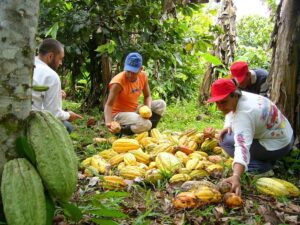
Industrial, Farming And Artisanal Fair
“This fair is also called agricultural, agroindustrial, forestry and artisanal and on some occasions it is accompanied by the cocoa and chocolate festival. This fair is an opportunity to establish business contacts at a local and national level, generating an economic movement with positive effects for local producers. The fair lasts 4 days, time that will serve to promote and present products from the region, learn more about the regional market, exchange knowledge. The agricultural fair opens its doors to exhibitors of all economic items, in order to offer and demand a diverse range of products and services. In Puerto Maldonado, the Artisanal and Forestry Farming Fair is organized from July 26 to 29 and the Third Cocoa Festival in Madre de Dios, a livestock, artisanal, forestry and tourism activity. The organizing committee invites the producers and entrepreneurs from different areas to ensure the success of the event. The annual fair also closes the celebrations for the anniversary of the city, and is also organized by the National University of Madre de Dios (UNAMAD), which has experience in the subject due to professional careers related to the activity that is drives in your breast. According to the established schedule, greater importance is given to local production in general for July 25, followed, on the 26th, by a sample of handicrafts, on the 27th of the agribusiness, on the 28th of the agricultural activity -where there is an exhibition of cattle obtained with artificial insemination, and on the 29th an exhibition of the forestry activity in the region. A great variety of gastronomy will also be presented in the area. In Madre de Dios there are several products derived from milk such as yogurt, butter, cheese and etc., to encourage their consumption, also the best yucca and other agricultural products are rewarded, in the framework of the big party popular. Every year important authorities and entrepreneurs from Brazil, Bolivia and other parts of Peru come to the agricultural fair of Madre de Dios, who are interested in making an exchange of commercial flow with the region. The program includes the exhibition of agricultural products, agricultural production, agroindustrial and artisan exhibition. It also announces folkloric activities, typical dance contests and musical concerts, among other activities. Mother of God has a very rich flora, and among which are species of noble wood and high interest. It has a formidable diversity of typical dishes, has the large number of wild animals domesticated for consumption. They are also abundant and diverse drinks like Masato, chapo, aphrodisiac drinks and many natural juices. Madre de Dios is home to some of the most biodiverse regions in the world. With parks and nature reserves such as the Manu National Park, the Tambopata National Reserve, Bahuaja Sonene National Reserve and many conservation areas.”
SEPTEMBER
25th
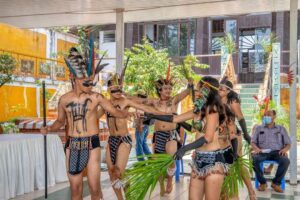
Do In Dari Feast- Fiesta De Mi Tierra
“Festival Sine Do End Dari (Feast of My Earth) in Madre de Dios The Sine Do End Dari Festival is held with the purpose of re-evaluating the traditions that Mother Earth has in mind. The name of this festival can also be found with the writing of Ndo Edn Dari, which means Fiesta de mi Tierra, it has a movable date, but it is usually carried out in the month of September. This celebration intends to call for the participation of the native communities so that they can present their own customs and traditions and in this way ensure that they are not lost. In other words this festival is to strengthen the cultural identity of the Amazon in which all the people of the different native communities show their culture, their customs, their folklore, together with their traditions. Sine Do End Dari has been celebrated since 2008 and in addition to the traditional exhibition of the Amazonian peoples is a good excuse to achieve the meeting between the native peoples and the city of Tambopata where it has realization. For this date different events are planned, among them traditional dance competitions can be found, as well as an exhibition of the typical foods of the different Amazonian communities that participate together with impressive ritual ceremonies where ayahuasca is present. Fair Sine Do End Dari, in the Harambukt language “”Feast of my Earth””, In this celebration the preparation of the mazato is carried out, accompanied by mystical songs. On this date there is the presence of artisans from different communities of Madre de Dios, such as Belgium and Hell, who meet to show the products with which they start their businesses. As in crafts, costume jewelery and painted looms. This fair is attended by national tourists and nationals from around the world who delight in the products offered and dance performances. These dances are from different communities like Ese Eja and Seri Pigari. There are also displays of rice piles, peeled and chestnut and crizneja cloth. The ritual of Ayahuasca is also presented by some native communities as the native community of hell”
OCTOBER
17th
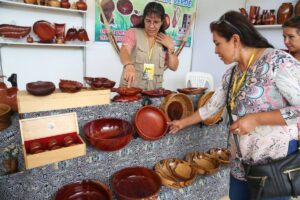
Jungle Native Food And Craft Fair
NOVEMBER
6th
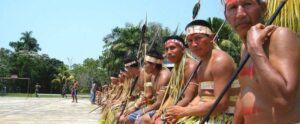
Palma Real Native Community Feast
DECEMBER
26th
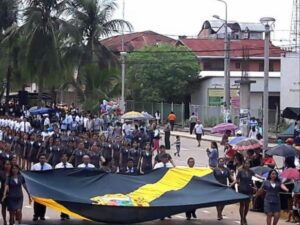
Madre De Dios Region Fundation Day
According to writings of the time, since the existence of the Inca Empire numerous expeditions were made in the area that today includes Madre de Dios, in order to extract the riches of this Amazonian region. Some legends speak of a place with a lot of gold called Paititi. Most of these expeditions failed. The Incas Sinchi Roca, Inca Yupanqui, as well as Pedro de Candia tried to reach this area. expeditions One of them was commanded by Colonel Faustino Maldonado, who traveled for the first time in all its extension the Madre de Dios River, until its union with the Madeira River, in Brazil. Carlos Fermín Fitzcarrald, in 1894, came to Madre de Dios in search of rubber, , the first commissioner of the region, Juan Villalta, wrote -with a knife- in a tree “”Puerto Maldonado””, thus founding this city on July 10, 1902. According to a legend that appears in the archives of Father Aza’s Paucartambo (1825 – 1848), the origin of the name of this region is due to the fact that an image of the Virgin Mary was found on one of the banks of the river. Another delegation that stood out was the representation of the Japanese colony in Madre de Dios. This came to the region in 1923, during the government of Leguía, mainly to work in the extraction of rubber. Several of these families settled in the communities and the city of Puerto Maldonado, mainly engaged in agriculture, wood carpentry and other manual activities.”
Related posts:
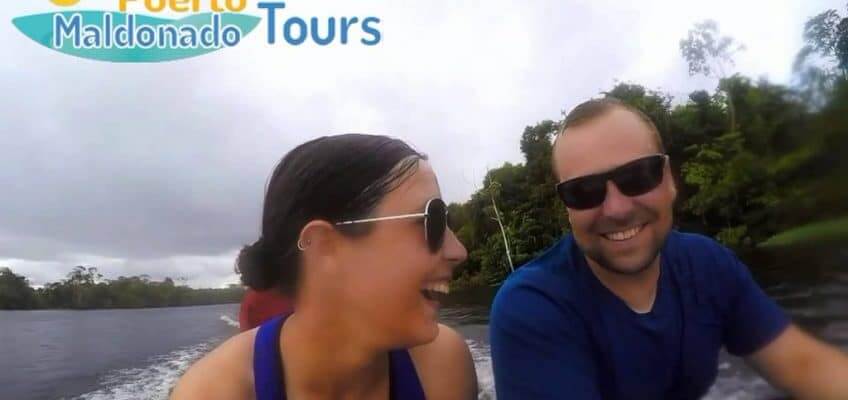 Puerto Maldonado tourism in amazon rainforest
Puerto Maldonado tourism in amazon rainforest
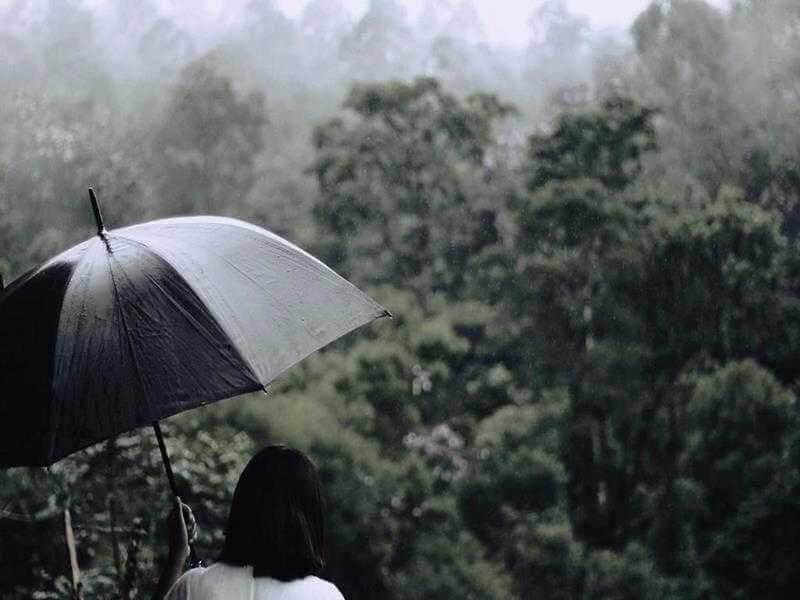 🌦️ Weather Forecast for Puerto Maldonado Today: What to Expect?
🌦️ Weather Forecast for Puerto Maldonado Today: What to Expect?
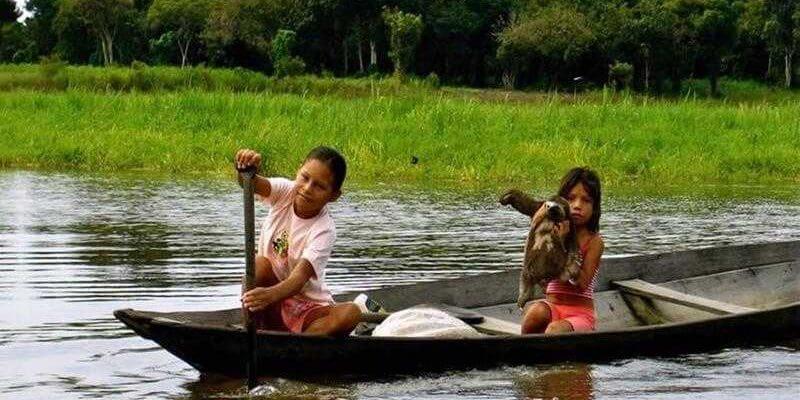 🎓 Jorge Basadre Grohmann Institute – Puerto Maldonado: Technical Education with an Amazonian Vision 🌿
🎓 Jorge Basadre Grohmann Institute – Puerto Maldonado: Technical Education with an Amazonian Vision 🌿
 The Continental Bridge of Puerto Maldonado
The Continental Bridge of Puerto Maldonado
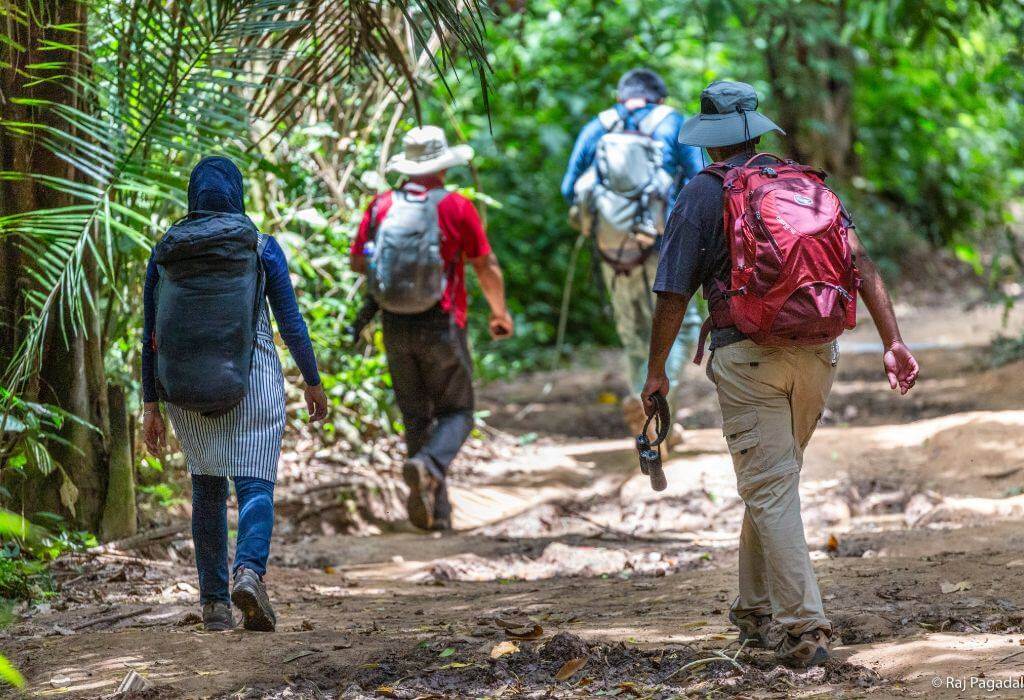 Adventure Lake – Amazon tours from Puerto Maldonado 4D
Adventure Lake – Amazon tours from Puerto Maldonado 4D
 What is the Postal Code of Puerto Maldonado?
What is the Postal Code of Puerto Maldonado?
 🌡️ Temperature in Puerto Maldonado: Tropical Weather in the Heart of the Amazon ☀️🌴
🌡️ Temperature in Puerto Maldonado: Tropical Weather in the Heart of the Amazon ☀️🌴
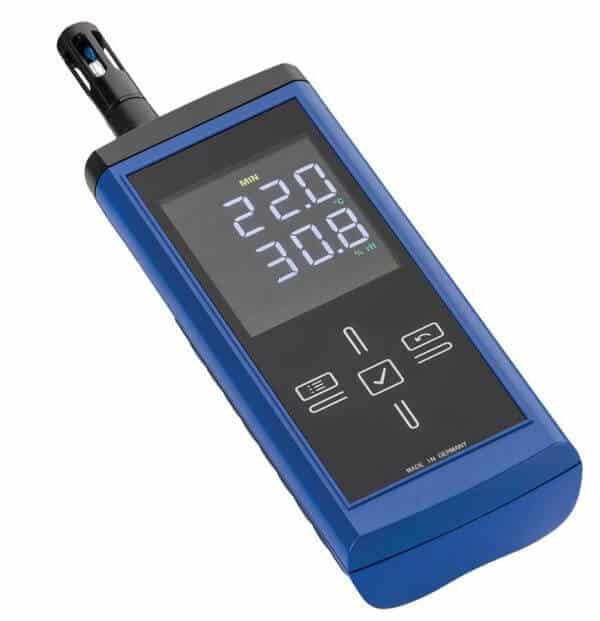 🌄 Puerto Maldonado Elevation: A Journey to the Heart of Peru’s Lowland Jungle
🌄 Puerto Maldonado Elevation: A Journey to the Heart of Peru’s Lowland Jungle
 🐒 Monkey Island in Puerto Maldonado
🐒 Monkey Island in Puerto Maldonado
 Lake Sandoval in Puerto Maldonado
Lake Sandoval in Puerto Maldonado
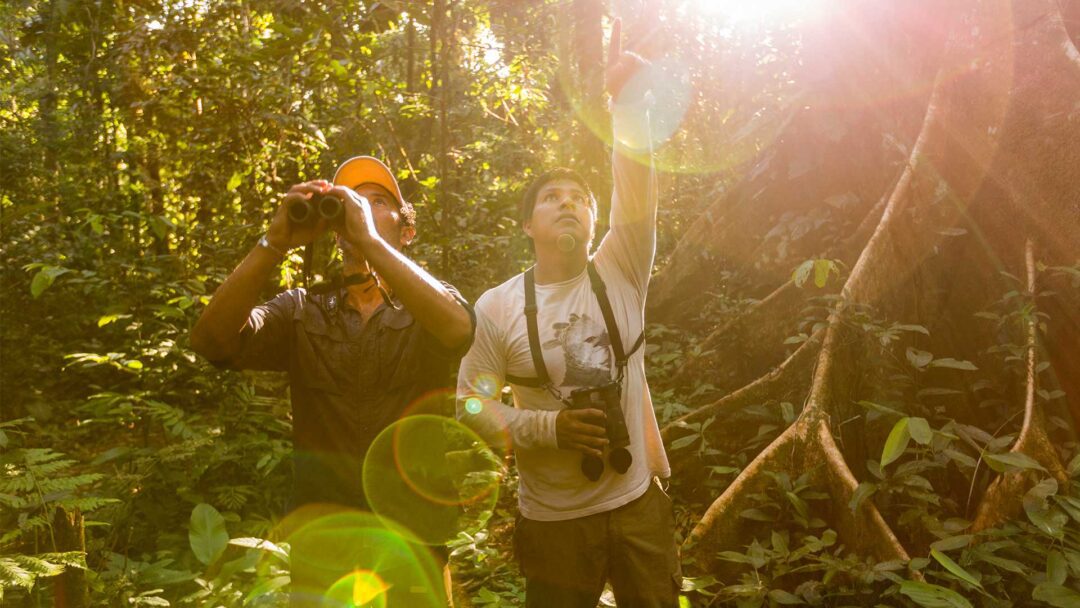 Discover Puerto Maldonado: Gateway to the Peruvian Amazon
Discover Puerto Maldonado: Gateway to the Peruvian Amazon